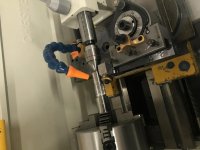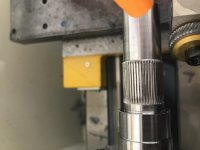Just end of last year I bought my first lathe, a chester db11vs. After the 2nd day of trying it out I knew something was up as the chatter was terrible. I found some videos and a forum post talking about this type of (chinese) lathes cross slide/top slide design being at fault. I didnt know how I was going to solve the problem at first apart from sending some designs for someone to make me, after many months I knew this wasnt going to happen, so I bought a Centec 2a and a Colchester Bantam cross/top slide assembly, along with all the various end mills and drill bits to go about modifying the slide to fit. I had to cut a 60deg dovetail angle in the cross slide and make new gibs, I went up to an m5x0.8 and drilled/milled out the cross slide to suit the slightly bigger bolts, reason being I snapped 2 bsw taps trying to make the gibs, In hindsight I could of drilled the starting hole bigger perhaps but its done now. It was a quite difficult on the mill due to the lack of travel, I made some fixture plates and made the cut in 2 ops, I made sure the 'miss' was that the final smaller cut would taper away so the dovetails mostly had a good mating, It was extremely close in the end so worked out great.
Just thought Id do a write up as some context and it might help someone if they are also having problems with their lathe of similar design, I can now make cuts with a square insert from 0.5-2mm doc (2.5mm triggers the breaker in the unit...) with a perfect finish in en19t, so the colchester parts have done the trick!
But heres the problem, it has a lack of torque, lack of bed length and lack of head rigidity as it will deflect the part and taper say 0.04mm even with it only sticking out the chuck 3 1/2", thats with both scmt and vbmt type inserts, although bigger scmt cuts will do it more which is understandable. With a live centre its almost none although It could still be 0.01 or so, its hard to tell with the calipers. I can with a lot of care, make 8mm round cuts which is something I need to be able to do reliably, the lathe wants to stall as I have to run the rpm quite low to lessen the spindle humming, It has stalled a couple times but I have better feel for it now.
With all this mind and the not so dear price of an older bigger lathe, Im thinking of just going for it and buying a Colchester Master 2500, the reason being over other lathes is the 2500 rpm, the current lathe goes up to 2500 also and with the 1" and below parts, the carbide inserts I like calls for those speeds.
So my question is, why shouldnt I buy one? It seemingly ticks all the right boxes, long bed, high rpm, 3ph 5hp motor, a lot heavier than the current lathe. I know there could be things that could do with some tidying up being an old lathe but I dont mind having to do that as long as it will give me many years of turning. I appreciate any advice given and thank everyone that have contributed on this forum already as the info has really helped me to get to where I am with machining.
Here are some pics of the setup. Briefly with the knurling, no matter what I do, it will not cut deep at all, It seems to form and not cut. The tool height I know is perfect, the angle is 2deg, I use coolant, it just seems to deflect when I try to plunge regardless of support or not. Ive tried changing the angle, the rpm, feed rate, same result everytime..
This is also why I want a bigger lathe as I feel the head or spindle bearings arent rigid enough, its a Quick 1.2mm wheel with a chinese tool, I dont know how it could be the tool being a 20mm shank, but someone might know.




Just thought Id do a write up as some context and it might help someone if they are also having problems with their lathe of similar design, I can now make cuts with a square insert from 0.5-2mm doc (2.5mm triggers the breaker in the unit...) with a perfect finish in en19t, so the colchester parts have done the trick!
But heres the problem, it has a lack of torque, lack of bed length and lack of head rigidity as it will deflect the part and taper say 0.04mm even with it only sticking out the chuck 3 1/2", thats with both scmt and vbmt type inserts, although bigger scmt cuts will do it more which is understandable. With a live centre its almost none although It could still be 0.01 or so, its hard to tell with the calipers. I can with a lot of care, make 8mm round cuts which is something I need to be able to do reliably, the lathe wants to stall as I have to run the rpm quite low to lessen the spindle humming, It has stalled a couple times but I have better feel for it now.
With all this mind and the not so dear price of an older bigger lathe, Im thinking of just going for it and buying a Colchester Master 2500, the reason being over other lathes is the 2500 rpm, the current lathe goes up to 2500 also and with the 1" and below parts, the carbide inserts I like calls for those speeds.
So my question is, why shouldnt I buy one? It seemingly ticks all the right boxes, long bed, high rpm, 3ph 5hp motor, a lot heavier than the current lathe. I know there could be things that could do with some tidying up being an old lathe but I dont mind having to do that as long as it will give me many years of turning. I appreciate any advice given and thank everyone that have contributed on this forum already as the info has really helped me to get to where I am with machining.
Here are some pics of the setup. Briefly with the knurling, no matter what I do, it will not cut deep at all, It seems to form and not cut. The tool height I know is perfect, the angle is 2deg, I use coolant, it just seems to deflect when I try to plunge regardless of support or not. Ive tried changing the angle, the rpm, feed rate, same result everytime..
This is also why I want a bigger lathe as I feel the head or spindle bearings arent rigid enough, its a Quick 1.2mm wheel with a chinese tool, I dont know how it could be the tool being a 20mm shank, but someone might know.









